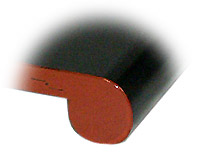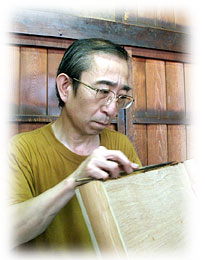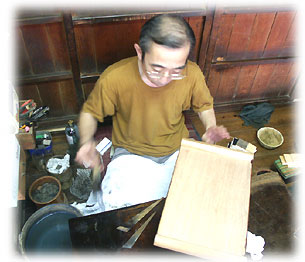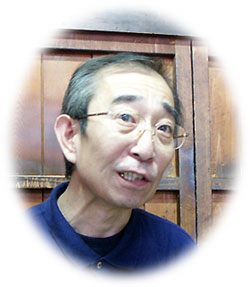|
| Lacquer ware in Japan dates back to the age of the Jomon era
(10,000B.C-300B.C). The earthen and wooden vessels coated with lacquer had been excavated from a shell mound, and they still had retained their beautiful colors and rest high durability as well.  Present technique are said to have been
brought to Japan through the Silk Road along with Buddhist culture from China. Present technique are said to have been
brought to Japan through the Silk Road along with Buddhist culture from China.There is clear evidence that Tamamushi Zushi in Horyuji Temple and Karatachi (Chinese swords) had all been brought to Japan at that time. Whereas pottery is called china in English, lacquer ware is called japan. The coating technique that came from China has developed in Japan and became even superior to that of China, taking up a comparable position amongst the cultures of the world. There was a time when a great number of cheap and imitation lacquer wares made of plastic were widespread putting Japanese lacquer ware at stake, However in recent years, as chemical items are increasingly feared for causing health problems, lacquer ware has become revalued for its environment ally friendly material. |
 Tell us about your job. Tell us about your job.We produce mainly lacquered vessels that are used in flower arrangement and tea Ceremony. 90% are vessels and 10% are utensils for tea Ceremony. After receiving orders from retail shops, we set to work, expecting to finish them within 3months. What was your motive for the work? I'm the forth in a line of this family business that has been continuing for many generations. In the early days of my childhood, I used to go to my father's work-shop and I became interested in the small works in the shop. I like to work surrounded with a lot of tools and, as a result, I automatically took over his job. What are the most difficult and time Consuming tasks?  Every process requires a great deal of
time, but we are especially expected to be skillful in judging the state of dryness. It is
essential to know about the condition of dryness. Every process requires a great deal of
time, but we are especially expected to be skillful in judging the state of dryness. It is
essential to know about the condition of dryness.Lacquer dries fast in high humidity, therefore it dries rapidly during the summer season. If it dries fast, the inside lacquer remains undried, Causing creases to form. In winter, on the contrary, since it takes a long time to dry we have to adjust the humidity by using sprayers on the walls to make a humid atmosphere. To keep up with the seasonal change of weather, we have to obtain the skill of being able to make delicate judgments and adjusting accordingly, I believe that there is no other alternative means but to acquire this skill through long experience.  What's your dream in the future? I would like to make something that requires an elaborate workmanship and that nobody else can do. If my work is remain the future. I want them to live as excellent works at art. This is my hope and I'll continue to work not as an artist, but as an artisan myself. |

